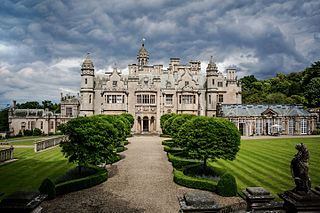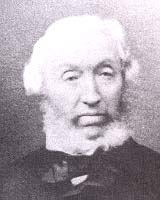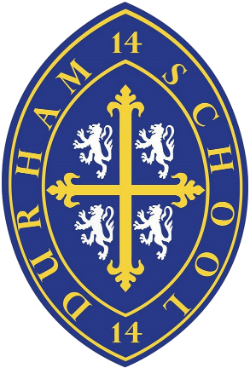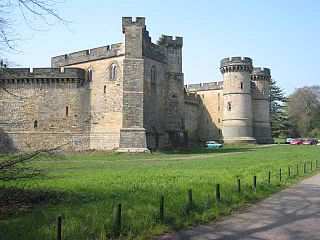
Burn Hall is a country house in County Durham. It is a Grade II* listed building. [1]

Burn Hall is a country house in County Durham. It is a Grade II* listed building. [1]
Around 1812, Bryan John Salvin of Croxdale purchased a manor house, dating back to the 13th century, called New Burnhall. Ignatius Bonomi redesigned it from 1821 to 1834 in the gothic and neoclassical style under the name Burn Hall. [1] It remained in the Salvin family until Marmaduke Henry Salvin died in 1924 and it was acquired by Saint Joseph's Missionary Society of Mill Hill which established a boys' school there. [2]
The seminary closed to full time students in 1995 when the costs of training priests became prohibitive. [3] The restoration of the main house and the redevelopment of the area to the rear by Jane Darbyshire Associates won the City Trust's architectural commendation of the year in 1998. [4]

Oxfordshire is a ceremonial and non-metropolitan county in South East England. It is locally governed by Oxfordshire County Council and the lower-tier authorities of its five non-metropolitan districts: City of Oxford, Cherwell, South Oxfordshire, Vale of White Horse, and West Oxfordshire. The county is landlocked and bordered by Northamptonshire to the north-east, Warwickshire to the north-west, Buckinghamshire to the east, Berkshire to the south, Wiltshire to the south-west, and Gloucestershire to the west. The area of Oxfordshire south of the River Thames was part of the historic county of Berkshire, including the county's highest point, the 261-metre (856 ft) White Horse Hill. The largest settlement in the county is Oxford, its only city, with an estimated population of 151,584.

Durham, is a cathedral city and civil parish on the River Wear, County Durham, England. It is an administrative centre of the County Durham District, which is a successor to the historic County Palatine of Durham.

The Jacobethan architectural style, also known as Jacobean Revival, is the mixed national Renaissance revival style that was made popular in England from the late 1820s, which derived most of its inspiration and its repertory from the English Renaissance (1550–1625), with elements of Elizabethan and Jacobean.

Harlaxton Manor is a Victorian country house in Harlaxton, Lincolnshire, England. It was built for Gregory Gregory, a local squire and businessman. Gregory employed two of the leading architects of Victorian England, Anthony Salvin and William Burn and consulted a third, Edward Blore, during its construction. Its architecture, which combines elements of Jacobean and Elizabethan styles with Baroque decoration, makes it unique among England's Jacobethan houses. Harlaxton is a Grade I listed building on the National Heritage List for England, and many other structures on the estate are also listed. The surrounding park and gardens are listed Grade II* on the Register of Historic Parks and Gardens. It is now the British campus of the University of Evansville.

Anthony Salvin was an English architect. He gained a reputation as an expert on medieval buildings and applied this expertise to his new buildings and his restorations. He restored castles and country houses, and built a number of new houses and churches.

Lumley Castle is a 14th-century quadrangular castle at Chester-le-Street in the North of England, near the city of Durham and a property of the Earl of Scarbrough. It is a Grade I listed building. It is currently a hotel.

Croxdale is a village in the civil parish of Croxdale and Hett, situated about 3 miles (4.8 km) south of Durham City, in County Durham, England and on the A167 road, formerly part of the Great North Road. It is on the route of the East Coast Main Line and at one time had a station. The railway crosses over Croxdale Viaduct, built in 1872, just north of the village. The Weardale Way long distance footpath passes through the nearby Croxdale Hall estate.

Raby Castle is a medieval castle located near Staindrop in County Durham, England, among 200 acres (810,000 m2) of deer park. It was built by John Neville, 3rd Baron Neville de Raby, between approximately 1367 and 1390. Cecily Neville, the mother of the Kings Edward IV and Richard III, was born here. After Charles Neville, 6th Earl of Westmorland, led the failed Rising of the North in favour of Mary, Queen of Scots in 1569 Raby Castle was taken into royal custody. Sir Henry Vane the Elder purchased Raby Castle in 1626 and neighbouring Barnard Castle from the Crown, and the Earls of Darlington and Dukes of Cleveland added a Gothic-style entrance hall and octagonal drawing room. From 1833 to 1891 they were the Dukes of Cleveland and they retain the title of Lord Barnard. Extensive alterations were carried out in the 17th and 18th centuries. It is famed for both its size and its art, including works by old masters and portraits. After 1733 it was frequented from his young age of eleven by the poet Christopher Smart, who eloped briefly at the age of thirteen with Anne Vane, daughter of Henry Vane, who succeeded to the Barnard title. It is a Grade I listed building and open to the public on a seasonal basis.

Pittington is a village and civil parish in County Durham, in England. It is situated a few miles north-east of Durham. The population as taken at the 2011 census was 2,534.
William Andrews Nesfield (1793–1881) was an English soldier, landscape architect and artist. After a career in the military which saw him serve under the Duke of Wellington, he developed a second profession as a landscape architect, designing some of the foremost gardens of the mid-Victorian era. These included Witley Court in Worcestershire, Castle Howard in Yorkshire, Treberfydd in Powys and Kew Gardens. He also established a professional dynasty; with his sons Arthur Markham and William Eden Nesfield, he developed over 250 landscapes across the United Kingdom.

Durham School is a fee-charging boarding and day school in the English public school tradition located in Durham, North East England and was an all-boys institution until 1985, when girls were admitted to the sixth form. The school takes pupils aged 3–18 years and became fully co-educational in 1998. A member of the Headmasters' and Headmistresses' Conference, it enrolls 650 day and boarding students. Its preparatory institution, known as Bow, Durham School, enrolls a further 160 pupils. Durham and Bow's former pupils include politicians, clergy and British aristocracy. Former students are known as Old Dunelmians. Founded by the Bishop of Durham, Thomas Langley, in 1414, it received royal foundation by King Henry VIII in 1541 following the Dissolution of the Monasteries during the Protestant Reformation. It is the city's oldest institution of learning.

Washington Old Hall is a historic manor house in Washington, Tyne and Wear, England. It lies in the centre of Washington, being surrounded by other villages. The building was the ancestral home of the family of George Washington (1732–1799), the first president of the United States.

Gosford Castle is a 19th-century country house situated in Gosford, a townland of Markethill, County Armagh, Northern Ireland. It was built for Archibald Acheson, 2nd Earl of Gosford, and designed in the Norman revival style by London architect Thomas Hopper. It is a Grade A listed building, and is said to be Ulster's largest. The Earls of Gosford occupied the castle until 1921, and the estate was later purchased by the Ministry of Agriculture to form Gosford Forest Park. The building subsequently deteriorated and in 2006 was sold to a development company who converted the castle into private dwellings.

Brancepeth Castle is a castle in the village of Brancepeth in County Durham, England, some 5 miles south-west of the city of Durham. It is a Grade I listed building.

Croxdale Hall is a privately owned country mansion situated at Croxdale near Sunderland Bridge, County Durham. It is a Grade I listed building.

Beamish Hall is a mid-18th-century country house, now converted to a hotel, which stands in 24 acres (97,000 m2) of grounds near the town of Stanley, County Durham. It is a Grade II* listed building.

Biddick Hall is a small privately owned 18th-century country mansion at Bournmoor, County Durham, near the City of Sunderland and Chester-le-Street. It is a Grade I listed building and the home of the Lambton family.

Thornton Hall is a privately owned 16th century manor house at High Coniscliffe, near Darlington, County Durham. It is a Grade I listed building.

The Abbey Church of Saint Peter and Saint Paul, Monkwearmouth–Jarrow, known simply as Monkwearmouth–Jarrow Abbey, was a Benedictine double monastery in the Kingdom of Northumbria, England.

Sunderland Bridge is a village in the civil parish of Croxdale and Hett, in the County Durham district, in the ceremonial county of Durham, England. It is about 3 miles (4.8 km) south of Durham city. In 1961 the parish had a population of 907.